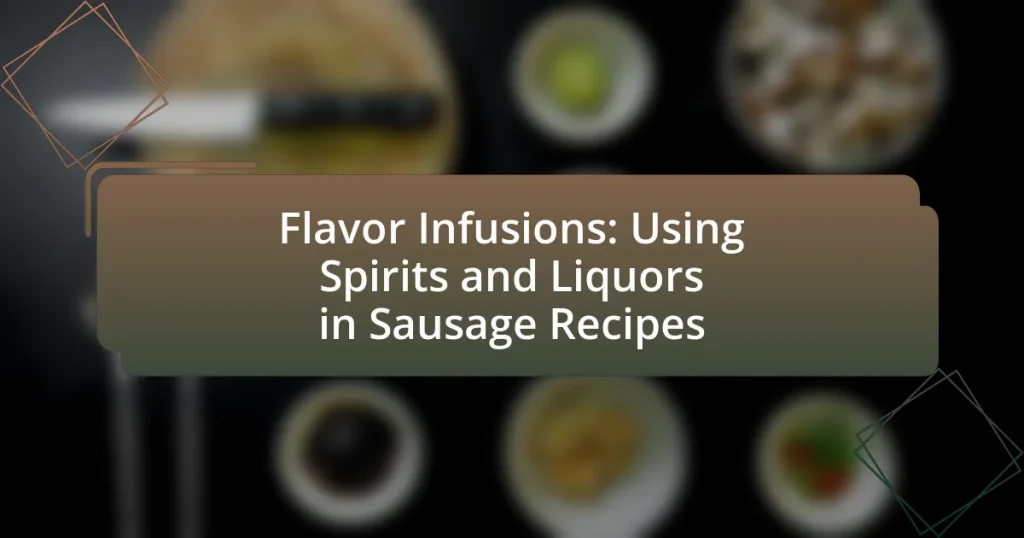Flavor infusions in sausage making involve the incorporation of various spirits and liquors to enhance the taste and aroma of sausages. This article explores how different alcoholic beverages, such as whiskey, rum, vodka, and brandy, contribute unique flavors and improve the overall sensory experience of the final product. It discusses the mechanisms by which alcohol extracts and amplifies flavors, the best practices for using spirits in recipes, and the impact of different types of meat on alcohol usage. Additionally, the article highlights common mistakes to avoid and provides creative sausage recipes that utilize spirits effectively.

What are Flavor Infusions in Sausage Making?
Flavor infusions in sausage making refer to the process of incorporating various spirits and liquors into sausage mixtures to enhance their taste and aroma. This technique allows for the introduction of complex flavors, as different alcoholic beverages can impart unique characteristics to the final product. For instance, whiskey can add a smoky depth, while wine may contribute acidity and fruitiness. The effectiveness of flavor infusions is supported by culinary practices that demonstrate how alcohol can extract and carry flavor compounds, making the sausages more flavorful and aromatic.
How do spirits and liquors enhance sausage flavors?
Spirits and liquors enhance sausage flavors by adding depth, complexity, and a unique aromatic profile. The alcohol content in spirits helps to dissolve and carry fat-soluble flavor compounds, which intensifies the overall taste experience. For instance, whiskey can impart smoky notes, while wine can contribute acidity and fruitiness, balancing the richness of the meat. Additionally, the fermentation process in some liquors can introduce subtle umami flavors, further enriching the sausage. Studies have shown that incorporating spirits can elevate the sensory attributes of food, making it more appealing to consumers.
What types of spirits are commonly used in sausage recipes?
Commonly used spirits in sausage recipes include whiskey, rum, vodka, and brandy. These spirits enhance the flavor profile of the sausage, with whiskey providing a smoky depth, rum adding sweetness, vodka contributing a neutral base, and brandy offering fruity notes. The use of these spirits is supported by culinary practices that emphasize the importance of alcohol in flavor extraction and enhancement during the cooking process.
How do different liquors affect the taste profile of sausages?
Different liquors significantly influence the taste profile of sausages by adding unique flavors and enhancing overall complexity. For instance, whiskey imparts a smoky, caramelized sweetness, while vodka contributes a neutral base that allows other spices to shine. Additionally, rum can introduce a rich, molasses-like sweetness, and gin adds herbal and botanical notes. These flavor enhancements occur due to the interaction of alcohol with fats and proteins in the meat, which can extract and amplify certain flavor compounds. Studies have shown that marinating sausages in liquor can lead to a more pronounced flavor profile, as the alcohol helps dissolve fat-soluble flavor compounds, making them more accessible to the palate.
Why incorporate alcohol in sausage recipes?
Incorporating alcohol in sausage recipes enhances flavor and moisture. Alcohol acts as a solvent, extracting and amplifying the flavors of spices and herbs used in the sausage mixture. Additionally, the presence of alcohol can improve the texture by helping to bind the ingredients together, resulting in a juicier product. Studies have shown that alcohol can also contribute to the overall aroma, making the final dish more appealing. For instance, spirits like whiskey or wine can add unique flavor profiles that complement the meat, enriching the overall taste experience.
What are the flavor benefits of using spirits in sausage?
Using spirits in sausage enhances flavor by adding depth, complexity, and unique aromatic profiles. The alcohol in spirits helps to extract and amplify the flavors of spices and herbs, resulting in a more robust taste. For example, whiskey can impart smoky notes, while rum may add sweetness and richness. Additionally, spirits can contribute to the overall mouthfeel and juiciness of the sausage, as they help to bind fat and moisture during the cooking process. This technique is supported by culinary practices that highlight the use of alcohol in flavor development, demonstrating its effectiveness in creating distinctive and memorable sausage varieties.
How does alcohol impact the texture and moisture of sausages?
Alcohol enhances the texture and moisture of sausages by acting as a solvent that extracts flavors and helps bind ingredients. When alcohol is incorporated into sausage mixtures, it can dissolve fats and proteins, leading to a more cohesive texture. Additionally, alcohol can retain moisture during the cooking process, preventing the sausages from drying out. Research indicates that the presence of alcohol can improve the overall juiciness and mouthfeel of the final product, making it more palatable.

What are the Best Practices for Using Spirits in Sausage Recipes?
The best practices for using spirits in sausage recipes include selecting complementary flavors, using spirits in moderation, and allowing adequate marination time. Complementary flavors enhance the overall taste; for example, whiskey pairs well with pork, while gin complements chicken. Moderation is crucial, as excessive alcohol can overpower other ingredients; typically, 1 to 2 ounces per pound of meat is recommended. Adequate marination time, ideally 12 to 24 hours, allows the spirits to infuse their flavors into the meat effectively, resulting in a balanced and flavorful sausage.
How much alcohol should be used in sausage making?
In sausage making, it is recommended to use alcohol at a ratio of about 1 to 2 ounces per pound of meat. This amount helps to enhance flavor and can aid in the preservation of the sausage. Studies have shown that alcohol can extract and carry flavors from spices and herbs, making it a valuable ingredient in sausage recipes.
What factors influence the amount of liquor to add?
The amount of liquor to add in sausage recipes is influenced by flavor balance, alcohol content, and the type of spirit used. Flavor balance is crucial; the liquor should complement the other ingredients without overpowering them. Alcohol content matters because higher-proof spirits can impart stronger flavors, necessitating smaller quantities. The type of spirit, such as whiskey, rum, or vodka, also affects the final taste profile, as each brings distinct characteristics that can enhance or alter the overall flavor of the sausage.
How does the type of meat affect alcohol usage in recipes?
The type of meat significantly influences alcohol usage in recipes, particularly in terms of flavor compatibility and absorption rates. For instance, fatty meats like pork or duck can absorb alcohol more effectively, enhancing the overall flavor profile, while lean meats such as chicken may require less alcohol to achieve a balanced taste. Research indicates that the fat content in meat interacts with alcohol, allowing for a richer infusion of flavors, as seen in traditional recipes where spirits are used to marinate or cook meats. This interaction is crucial in sausage-making, where the choice of meat directly impacts the amount and type of alcohol used to achieve desired flavor outcomes.
What are the common mistakes to avoid when infusing flavors?
Common mistakes to avoid when infusing flavors include using insufficient time for infusion, which can lead to weak flavor profiles. Additionally, over-infusing can result in bitter or overpowering tastes. Not balancing flavors properly, such as failing to consider the base ingredient’s characteristics, can also detract from the overall quality. Using low-quality spirits or ingredients can compromise the infusion’s final taste, as higher quality components yield better results. Lastly, neglecting to strain the infusion properly can leave unwanted particles, affecting both flavor and texture.
How can overuse of alcohol negatively impact sausage flavor?
Overuse of alcohol can negatively impact sausage flavor by overpowering the other ingredients and creating an unbalanced taste profile. When excessive alcohol is added, it can mask the natural flavors of the meat and spices, leading to a harsh or bitter aftertaste. Additionally, high alcohol content can inhibit the Maillard reaction, which is essential for developing complex flavors during cooking. Studies have shown that optimal alcohol levels enhance flavor, while excessive amounts detract from the overall sensory experience, resulting in a less enjoyable product.
What are the signs of improperly infused sausages?
Improperly infused sausages exhibit several signs, including uneven flavor distribution, where certain sections taste significantly stronger or weaker than others. Additionally, a lack of aroma or an off-putting smell can indicate improper infusion, as well as a dry or crumbly texture, which suggests that the infusion process did not adequately incorporate moisture or flavor. These signs are critical because they reflect the infusion technique’s effectiveness, impacting the overall quality and palatability of the sausage.

What are Some Popular Sausage Recipes with Spirits?
Some popular sausage recipes with spirits include beer brats, bourbon-infused sausage, and whiskey sausage. Beer brats are made by simmering bratwurst in beer before grilling, enhancing the flavor with the beer’s maltiness. Bourbon-infused sausage incorporates bourbon into the meat mixture, adding a rich, sweet flavor profile. Whiskey sausage often features whiskey in the seasoning blend, providing a smoky depth. These recipes leverage the unique characteristics of spirits to create distinct and flavorful sausages.
How can whiskey be used in sausage recipes?
Whiskey can be used in sausage recipes as a flavor enhancer and a moisture-retaining agent. When incorporated into the meat mixture, whiskey adds depth and complexity to the flavor profile, complementing spices and herbs. Additionally, the alcohol content helps to dissolve fat-soluble flavors, ensuring a more uniform taste throughout the sausage. Studies have shown that spirits like whiskey can enhance the overall sensory experience of meat products, making them more appealing to consumers.
What are the key ingredients in whiskey-infused sausage?
The key ingredients in whiskey-infused sausage typically include ground meat (such as pork or beef), whiskey, spices (like black pepper, garlic powder, and paprika), and a binding agent (such as fat or breadcrumbs). Ground meat serves as the primary base, while whiskey adds distinct flavor and aroma. Spices enhance the overall taste profile, and the binding agent ensures the sausage maintains its structure during cooking. These components work together to create a unique flavor experience that highlights the whiskey infusion.
What cooking techniques enhance whiskey flavors in sausage?
Smoking enhances whiskey flavors in sausage by infusing the meat with aromatic compounds from the wood, which complements the whiskey’s notes. Techniques such as slow cooking and braising also allow the whiskey to meld with the sausage, creating a deeper flavor profile. Additionally, marinating the sausage in whiskey before cooking can intensify the spirit’s characteristics, as the alcohol extracts flavors from the spices and meat. These methods are supported by culinary practices that emphasize the importance of time and temperature in flavor development, ensuring that the whiskey’s essence is fully integrated into the sausage.
What unique flavors can rum bring to sausage dishes?
Rum can bring unique flavors to sausage dishes by adding notes of sweetness, caramel, and spice. The inherent characteristics of rum, particularly dark and spiced varieties, enhance the savory profile of sausages, creating a complex flavor experience. For instance, the molasses base of rum contributes a rich sweetness that balances the saltiness of the meat, while spices like cinnamon and nutmeg found in spiced rums can complement herbs and seasonings used in sausage recipes. Additionally, the alcohol content in rum helps to tenderize the meat, allowing for deeper flavor absorption during cooking.
How does rum pair with different types of meat in sausages?
Rum pairs well with various types of meat in sausages by enhancing their flavors through its natural sweetness and complexity. For instance, when combined with pork, rum complements the meat’s richness and adds a caramelized note, making it ideal for sweet and savory sausage blends. In the case of beef, rum’s boldness can balance the meat’s robust flavor, particularly in spiced or smoked sausages. Additionally, when used with poultry, rum can infuse a subtle sweetness that enhances the overall taste profile, especially in sausages that incorporate fruits or spices. The versatility of rum in these pairings is supported by culinary practices that highlight its ability to elevate the flavor experience in sausage recipes.
What are some creative rum-infused sausage recipes?
Creative rum-infused sausage recipes include Caribbean Jerk Rum Sausage, which combines ground pork with spices like allspice and thyme, along with dark rum for a tropical flavor. Another option is Rum and Apple Sausage, where ground pork is mixed with diced apples, cinnamon, and a splash of spiced rum, creating a sweet and savory profile. Additionally, a Rum-Glazed Sausage can be made by incorporating a rum reduction with brown sugar and mustard into the sausage mixture, resulting in a sticky, flavorful finish. These recipes leverage rum’s unique flavor profile to enhance the overall taste of the sausages.
What tips can help achieve the best flavor infusion results?
To achieve the best flavor infusion results in sausage recipes using spirits and liquors, it is essential to select high-quality ingredients that complement the meat. Using spirits with distinct flavors, such as whiskey or rum, enhances the overall taste profile. Additionally, marinating the meat for an adequate duration, typically 24 hours, allows the flavors to penetrate deeply. The infusion process is further optimized by incorporating complementary spices and herbs, which can enhance the spirit’s flavor. Studies show that alcohol can extract flavor compounds from herbs and spices more effectively than water, making it a superior medium for infusion.
